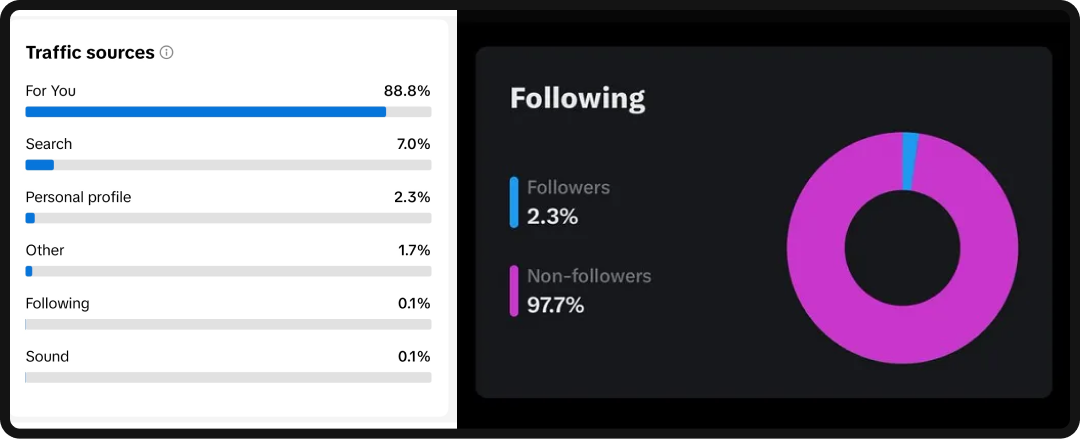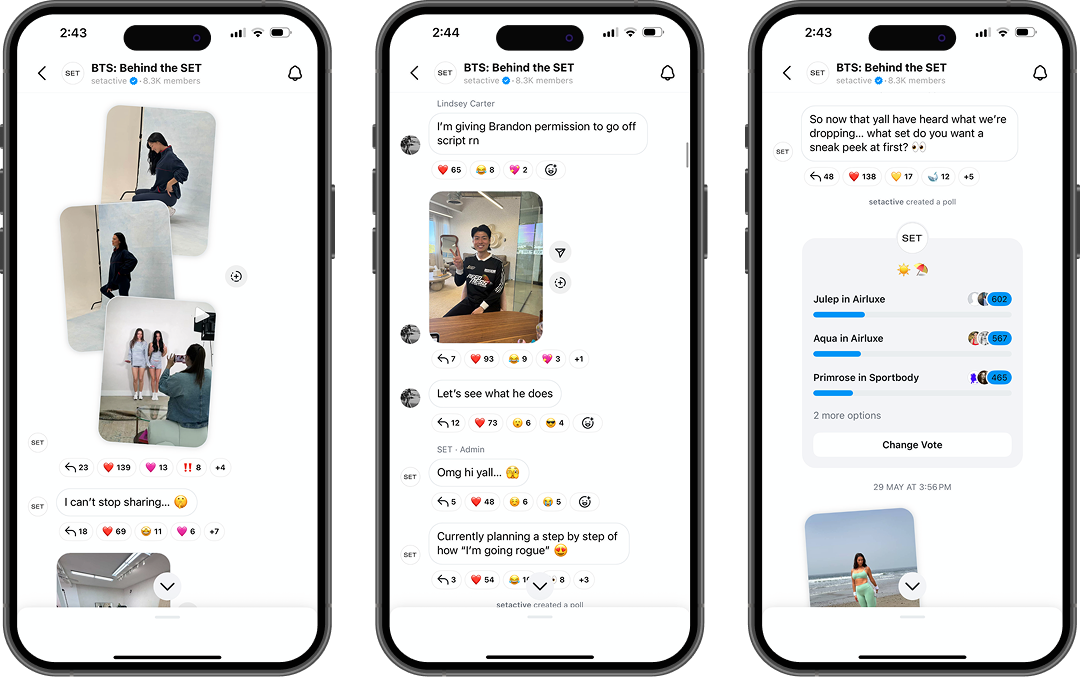We’re witnessing the death of the follower count in real time. Those that follow you don’t see your content, and those that engage with your content don’t actually translate into followers. The widening gap between who follows you and who actually views and engages with your content is pointing to one thing: follower counts just don’t hold the same value that they used to anymore.
This shift demands a fundamental rethinking of how we measure social media success. Content strategists and social media managers are being pushed to evolve measurement practices away from vanity metrics and toward what actually demonstrates impact.
Here’s the uncomfortable truth: you don’t own your followers; the platform does. What you do own is your content and the reach it generates, regardless of who’s technically “following” you. If a viral post can reach millions of non-followers while your actual followers scroll past your content, clinging to follower count as a key performance indicator isn’t just outdated, but actively misleading.
The metrics that matter now tell a completely different story about your social media impact, and it’s time we start paying attention to them.
Breaking Down the Follower Fallacy
The baseline definition of a “follower” is simple: someone who clicks the “follow” or “subscribe” button on a social media profile or page.
For years, this definition came with an implied understanding: that a follower is someone actively opting into viewing, liking, and potentially sharing your content with their own network. It was a clear transaction: they follow you, they see your posts, they engage.
The problem? While the baseline definition remains unchanged, the actual value and function of a follower has been fundamentally disrupted.
The follower fallacy boils down to one critical misunderstanding: treating the follower as a functional marker of your audience when it has become merely symbolic. With the rise of algorithm-driven feeds and search-driven platform behaviors, the majority of people who see your content aren’t following you at all.
Similarly, most of your followers aren’t seeing your content in their feeds. Users are now primarily consuming whatever the algorithm serves them based on their behavior, interests, and engagement patterns, and not based on who they consciously chose to follow months or years ago.
Consider this reality check: some of your most dedicated viewers (the ones who watch your videos all the way through, save your posts for later, or visit your profile repeatedly) will likely never click the follow button. And why would they? The algorithm already delivers your content to their feed without requiring that commitment. Think about it like subscribing to a magazine that keeps showing up on your doorstep whether you subscribe or not. The follow button has lost its functional purpose.

On the flip side, you likely have thousands of followers who haven’t seen a single post from you in months; either because the algorithm deprioritized your content in their feed, or because their interests have shifted and they engage with different content now.
This doesn’t mean followers are completely worthless, but it does mean you can’t view the follower count metric in isolation (or treat it as a reliable indicator of reach, influence, or impact). Follower count is one data point in a much larger picture, and it’s very often not even the most important one.
The sooner we stop obsessing over this vanity metric and start looking at what actually demonstrates content performance and audience connection, the better equipped we’ll be to achieve real, tangible growth.
The Turning Point of the “For You” Page”
Most people think that TikTok’s biggest innovation was the vertical short-form video feed, but that’s not the case. The real innovation is their proprietary algorithm and content delivery system. TikTok changed the game with their well-oiled machine of a “For You” page that serves users content based on an intricate mix of their viewing behavior, engagement patterns, watch time, and interest signals.
It’s engineered to keep users engaged and scrolling while continuously collecting data to refine what they see next.
There’s a reason people say, “I built this FYP brick by brick.” It’s true. Every video watched, every like given, and every swipe away is training the algorithm to understand that user’s preferences. The feed becomes hyper-personalized, often surfacing content from creators the user has never heard of, simply because the algorithm determined it matches their taste profile.
TikTok pioneered this approach, and Instagram Reels and YouTube Shorts quickly followed suit, marking a fundamental turning point in how we consume content online: we’ve moved from follower-driven feeds to algorithm-driven discovery.

For creators, this shift has completely changed the playbook. Smart creators are optimizing for algorithmic distribution instead of followers. You’ll notice that many successful TikToks or Reels have a very similar pattern: videos open with an immediate hook, followed by an introduction like, “Hi, my name is [blank] and this is part 1 of my series where I [blank].”
This isn’t accidental. Every single video is treated as a standalone opportunity to reach net-new users who have never encountered your content before. People don’t follow people anymore; they follow algorithmically-curated feeds built around their interests.
The fundamental question creators must now ask isn’t “How do I get more followers?” but rather “What value am I providing, and how do I signal to the algorithm that my content deserves to appear in curated feeds?” Those who solve for algorithmic distribution will reach exponentially more people than those still chasing follower counts. The follow button may have become optional, but the algorithm’s approval matters more now than ever before.
What Is the Most Important Metric for Social Media?
Trick question; there is no “most important metric” for social media. The value of social media metrics is in the ability to use them in conjunction with one another to paint a bigger picture of the influence and impact of your content.
It can be helpful to think of social media metrics as existing in three distinct layers, each serving a different purpose in understanding your performance.
Layer 1: Platform-Native Metrics
Layer 1 consists of platform-native metrics, meaning the data you can pull directly from Instagram Insights, TikTok Analytics, or YouTube Studio etc. These metrics are indicative of individual content performance and reveal how well your content resonates with audiences and penetrates the algorithm. These are your real-time feedback signals that tell you whether your content is breaking through the noise and keeping people’s attention.
- Views: The number of times your content has been seen. This is your baseline visibility metric, though the definition varies by platform (some count a view at 3 seconds, others immediately).
- Reach: The number of unique accounts that have seen your content. Unlike views, which can count the same person multiple times, reach tells you the actual size of your audience (not to be confused with follower base) for a given piece of content.
- Impressions: The total number of times your content was displayed on someone’s screen, including multiple views from the same user. This helps you understand repeat exposure and content stickiness.
- Engagements: Any interaction with your content, including likes, comments, saves, and shares. This is the clearest signal that your content resonated enough for someone to take action.
- Engagement Rate: The percentage of people who engaged with your content relative to how many people just saw it (engagements divided by reach or impressions). This normalizes engagement data so you can compare performance across posts with different reach levels.
- Watch Time: The total amount of time people spent watching your video content. Platforms heavily weight this metric in their algorithms (longer watch time signals valuable content).
- Completion Rate: The percentage of viewers who watched your video all the way through. High completion rates tell the algorithm your content is engaging enough to hold attention, making it more likely to be distributed widely.
- Profile Visits: How many people clicked through to view your profile after seeing your content. This indicates growing interest and intent to learn more about your brand.
Layer 2: Conversion Metrics
Layer 2 encompasses conversion metrics, which tie more directly to business goals. The primary metric here is web traffic driven from organic social, typically measured through tools like GA4.
It’s critical, however, to set realistic expectations: organic social traffic is often modest, and that’s okay. Organic social media isn’t primarily a conversion channel, and it’s not meant to be; it’s more of a brand-building channel. Most platforms are deliberately designed to keep users scrolling within the platform, not clicking out to external websites.
The reality is that users rarely click “link in bio.” Instead, they consume your content over time, build positive sentiment around your brand, and later convert through paid ads, direct traffic, or search after your brand has already earned their trust through organic content.
- Website Traffic from Social: The number of users landing on your website directly from social media platforms, tracked through UTM parameters or referral sources in GA4. This shows when social content successfully drives people off-platform to learn more or take action.
- Click-Through Rate (CTR): The percentage of people who clicked a link in your post, bio, or story relative to how many people saw it. Even if the numbers are low, this metric reveals which content prompts curiosity strong enough to overcome platform friction.
- Link Clicks: The raw number of clicks on any links within your social content. This is particularly relevant for stories, bio links, or posts with embedded URLs.
- Influenced or Assisted Conversions: Tracked in analytics platforms, these show conversions where social media was part of the customer journey even if it wasn’t the final touchpoint. This captures social’s true role as a brand-building tool that influences later conversions through other channels.
Layer 3: Brand Tracking Metrics
Layer 3 covers brand tracking metrics, which measure the intangible but invaluable outcomes of consistent social presence. This includes sentiment analysis, share of voice, brand mentions (both tagged and untagged), word clouds that reveal how people talk about your brand, and overall brand visibility across platforms.
These metrics capture the cumulative effect of your social media efforts on brand perception and awareness, which is often the hardest to measure but most important for long-term growth.
- Sentiment Analysis: Evaluates whether conversations about your brand are positive, negative, or neutral. This is typically measured through social listening tools that analyze the language and context around brand mentions to gauge public perception.
- Share of Voice: Your brand’s visibility within relevant conversations compared to competitors. If 100 social posts mention brands in your category and 25 mention yours, you have a 25% share of voice; a key indicator of market presence.
- Brand Mentions (Tagged & Untagged): How often people talk about your brand across social platforms, whether they officially tag you or not. Untagged mentions (often tracked using social listening tools) often reveal authentic, organic conversations that are particularly valuable for understanding true brand perception.
- Word Clouds & Conversation Themes: Visual representations of the most common words and phrases associated with your brand in social conversations. These reveal what attributes, products, or experiences people most associate with you.
- Branded Search Volume: How often people search for your brand name on social platforms or Google after encountering your content. Rising brand searches indicate successful awareness-building.
- Follower Quality & Demographics: Not just how many followers you have, but who they are: their demographics, interests, and behaviors. Quality matters far more than quantity when evaluating whether you’re reaching your actual target audience.
Together, these three layers create a comprehensive measurement framework. Platform-native metrics tell you if your content works. Conversion metrics tell you if it drives action. Brand tracking metrics tell you if it changes perception. Use them together, and you’ll see the full picture of your social media impact.
Social Media Metrics for Measuring Impact
|
Layer |
Metric Category |
Key Metrics |
What It Measures |
Primary Purpose |
|---|---|---|---|---|
|
Layer 1 |
Platform-Native Performance |
|
How individual content performs and resonates with audiences |
Real-time content feedback; understanding algorithmic distribution |
|
Layer 2 |
Conversion Metrics |
|
Whether content drives specific business actions |
Connecting social efforts to business outcomes (with realistic expectations) |
|
Layer 3 |
Brand Tracking |
|
Long-term brand perception and awareness impact |
Understanding cumulative effect on brand health and market position |
Social Search: An Alternative Route of Search-Driven Content Discovery
Social search (users using social media platforms like TikTok and Youtube as search engines), is another major force rendering follower counts obsolete.
Think about the traditional model of content discovery on social media: users either see content from accounts they follow, or the algorithm serves them content in their feed. But social search introduces a third route of discovery that operates completely independent of both your follower count and algorithmic distribution. When someone searches “best coffee in Brooklyn” on TikTok or “how to fix a leaky faucet” on YouTube, your content can surface in those results regardless of whether that person follows you or whether the algorithm would have otherwise shown them your content in their feed.
This matters enormously when we talk about the death of the follower count because search-driven discovery fundamentally decouples reach from followers. A creator with 500 followers can outperform a creator with 50,000 followers if their content is better optimized for the search terms people are actually using. Your searchable content has the potential to reach people who would never discover you through the For You page, who would never think to follow you, but who are actively looking for exactly what you’re offering.
When users find your content through search, they’re exhibiting high intent. They’re not passively scrolling; they’re actively seeking information, solutions, or recommendations. This makes search-optimized content particularly valuable for building authority and trust, even if those viewers never convert into followers. They found what they needed, consumed it, and moved on, but your brand made an impact in that moment of need.
Social search reinforces a central truth: your content’s value isn’t measured by how many people follow you, but by how many people can find and benefit from what you create. Whether they discover you through algorithmic feeds, intentional searches, or even direct shares, reach and resonance matter far more than follower status.
Gated Platforms & Closed Communities: Taking Back Control From the Algorithm
The shift away from follower counts is actively being built into the architecture of emerging brand community spaces. Closed brand communities and gated platforms represent the ultimate rejection of algorithmic control, creating environments where users and brands reclaim the power to decide what they see and who they connect with.
In fact, some even say that it’s cool to have a low follower count now. Think about Discord servers, Instagram Broadcast Channels, WhatsApp Communities, Slack groups, Substack subscriptions, or Patreon memberships. In these spaces, there is no algorithm deciding what content surfaces. No black-box recommendation engine filtering what you see. No “For You” page intermediary standing between creators and their audience. Instead, when you join a closed community or subscribe to a gated platform, you’re making an intentional choice to see everything that the creator or brand publishes. It’s a return to the original promise of the “follow” button: opting in actually means opting in.

This represents a direct response to algorithm fatigue. As users have lost control over their public feeds, closed communities offer an escape hatch. They restore agency to both sides of the relationship. Brands can communicate directly with their most engaged audience without competing for algorithmic favor. Users can curate their own experience based on genuine interest rather than whatever the platform’s engagement-optimization machine decides to serve them.
Industry & Competitive Benchmarking for Social Media Metrics
If follower count is no longer a reliable indicator of social media success, then what should you be benchmarking against? The answer requires a fundamental shift in how we think about competitive analysis. Rather than looking at surface-level vanity metrics like who has the most followers or likes, effective benchmarking now demands that we dig deeper into the metrics that reveal actual impact and algorithmic performance.
- Pay attention to content velocity and consistency within your competitive set. How often are competitors posting? What formats are they using? More importantly, which of their posts are breaking through algorithmically versus falling flat?
- Track their best-performing content over time to identify patterns in what the algorithm rewards in your industry. Are educational carousel posts outperforming aesthetic single images? Are quick-hit Reels driving more reach than polished productions?
These patterns reveal where the algorithmic winds are blowing.
Benchmark qualitative signals that traditional analytics miss. Are competitors building closed communities or launching Substacks? Are they getting (or leaving) high-quality comments that spark conversations, or just emoji reactions? Are they appearing in social search results for relevant industry terms? Are other creators and brands engaging with their content, signaling authority and network effects? These softer indicators often predict future growth better than current follower counts.
Approach benchmarking in a way that recognizes that you’re not competing for followers anymore; you’re competing for algorithmic distribution, audience attention, and genuine engagement. That means comparing yourself against competitors who are winning on those fronts, regardless of their follower count.
A scrappy competitor with 5,000 followers whose content consistently goes viral and drives conversations is a more important benchmark than an established player with 500,000 followers posting into the void. Identify who’s actually breaking through, reverse-engineer what’s working for them, and measure your performance against those standards.
Organic Social Metrics & Measurement Are Growing Up
The death of the follower count isn’t something to mourn. This shift levels the playing field in ways we haven’t seen since the early days of social media. Startups and emerging brands now have a genuine opportunity to compete with legacy players, not by accumulating followers over years, but by creating content that breaks through algorithmically, ranks in social search, and resonates with the right audiences.
The brands that will thrive in this new era are the ones willing to evolve how they track, measure, and understand social media success. They’re looking beyond vanity metrics to focus on reach, engagement quality, watch time, search visibility, and community depth. They’re building for algorithmic distribution while simultaneously creating spaces where algorithms don’t control the conversation. In short, they’re measuring what matters, not what’s easy to count.
This maturation of organic social measurement demands more sophisticated thinking, but it also offers more accurate insights. When you stop obsessing over follower counts and start analyzing the three layers of metrics (platform performance, conversion signals, and brand health), you gain a complete picture of your actual impact. You can make informed decisions about content strategy, resource allocation, and where to invest your efforts for maximum return.
The future belongs to brands that get it: influence isn’t about how many people clicked follow. What matters is how many people you reach, how deeply you engage them, and how effectively you build lasting connections.
Death of Followers FAQs
What are some KPIs for social media?
The most important KPIs go far beyond follower count: focus on reach, impressions, engagement rate, watch time, completion rate, saves, and shares for content performance. For business impact, track website traffic from social and conversion attribution. For brand health, monitor sentiment analysis, share of voice, and brand mentions.
Why doesn’t follower count matter anymore?
Algorithm-driven feeds mean most of your followers never see your content, and most people who engage with your content don’t follow you. Platforms prioritize content based on user behavior and interests, not who someone follows, which means follower count tells you nothing about actual reach or impact.
What is the 70/20/10 rule in social media?
The 70/20/10 rule is a content strategy framework: 70% proven content that consistently performs well, 20% experimental content testing new formats or trends, and 10% high-risk, bold content that pushes boundaries. This balance helps brands maintain consistency while innovating and staying relevant.
What is the 50/30/20 rule for social media?
The 50/30/20 rule suggests a content mix of 50% educational or entertaining content that provides value, 30% brand story and culture content that builds connection, and 20% promotional content about products or services. This ensures you’re not overly promotional while still achieving business objectives.
How do I know if my social media strategy is working without focusing on followers?
Look at trends across multiple metrics over time: Are your reach and impressions growing? Is engagement rate consistent or improving? Are you seeing longer watch times and more brand mentions? Success is about sustained growth in reach and engagement quality, not follower accumulation.
What’s the difference between reach and impressions?
Reach measures unique accounts that saw your content, while impressions count total views including repeats from the same account. Both matter: reach tells you audience size, while impressions indicate whether people are returning to view your content multiple times.
Should I completely ignore follower count?
Don’t ignore it completely, but stop treating it as a primary success metric. Follower count can indicate brand awareness, but it means nothing if your reach is declining or engagement is dropping. Think of it as one small data point in a much larger measurement framework.
How often should I be tracking and analyzing my social media metrics?
Check platform-native metrics like reach and engagement weekly to optimize your content strategy in real-time. Analyze conversion metrics and brand tracking monthly or quarterly since they take longer to show meaningful patterns. Consistency in tracking is key to spotting trends and making data-informed decisions.





